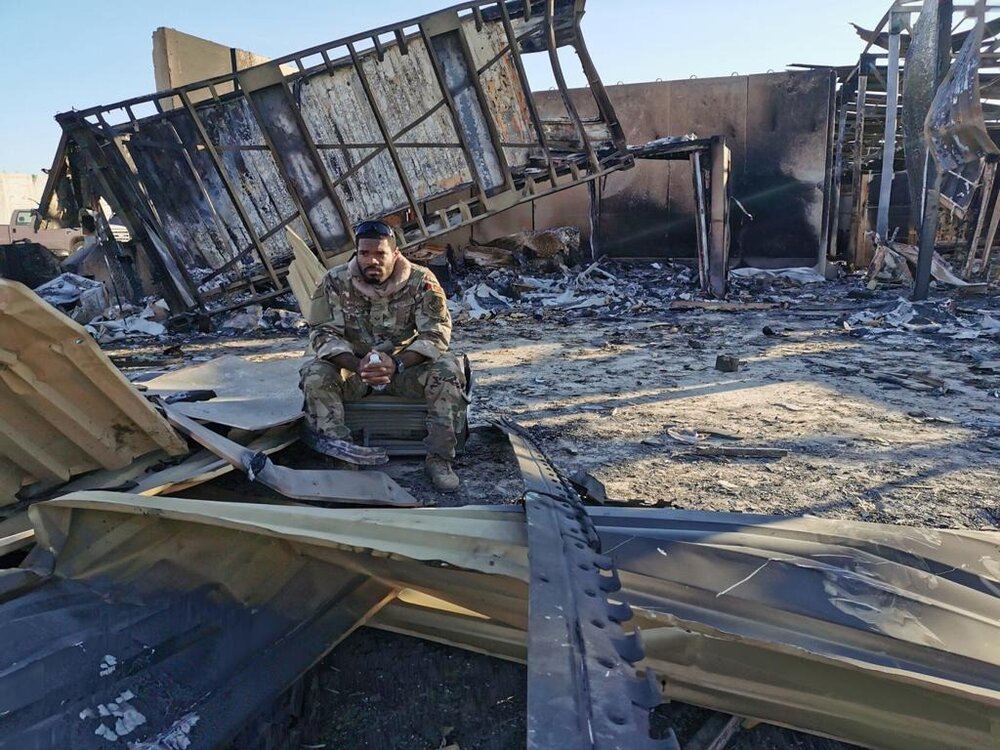Night-long nightmares, one year after Iran's retaliation

TEHRAN – An American newspaper has broken the story of some U.S. troops who survived Iran's missile attack on American military bases in Iraq on the early hours of January 8, 2020, in revenge for the assassination of Lt. Gen. Qassem Soleimani by the American government.
Many American soldiers are still dealing with psychological disorders after the attack on that night, The Washington Post said in a report on Sunday titled "These U.S. troops survived one of the greatest crises of Trump era. A year later, they're still coping".
A number of soldiers describe their personal experiences in Ain al-Asad airbase in Al Anbar province in western Iraq that Iran showered it several long-range missiles on the dead of the night.
The assassination of the top general on the early hours of January 3 dragged the U.S. and Iran close to full-scale war. Iranian officials have since emphasized that the missile attack was "just part of the revenge" that they have planned as a response to the crime that the U.S. committed.
Facing the gravest international security crisis of his presidency, Donald Trump suddenly shifted gears. "All is well!" he tweeted within hours of the attack.
"The U.S. soldiers scrambled from one bunker to the next, stumbling past charred wreckage, 30-foot-wide craters, and puddles of diesel fuel. A barrage of ballistic missiles had briefly knocked some of them unconscious, and more were on the way," says The Washington Post.
"Iran used weapons about 40 long and carrying 1.600 pounds of explosives, more powerful than any weapon launched at Americans in a generation," the Post adds.
It also says, "But 110 survivors were ultimately diagnosed with traumatic brain injuries, some requiring long hospitalizations and intensive therapies at the Walter Reed National Military Medical Center outside Washington. The military disclosed the injures days after the strike, saying that an earlier Trump announced that there were 'no casualties' was based on the best information the Pentagon had at the time".
One of the soldiers interviewed by the Post is Maj. Alan Johnson. He says, "I struggled to focus after absorbing the monstrous blast waves of several explosions, including one that missed my bunker by about 60 feet" he recalled, adding, "I still have anxiety. I still have recurring nightmares of incoming – just that sound of those things coming in."
Johnson and 28 other service members were injured seriously enough to receive Purple Hearts in the strike, which Iran called Operation Martyr Soleimani. The attack left some with feelings of anger and helplessness. Survivors are still pondering a night that increasingly seemed overlooked in a year that went on to include the coronavirus pandemic, a fraught national conversation about race, and one of the most contentious presidential elections in American history, the newspaper says.
Another American trooper interviewed is Lt. Col. Johnathan Jordan, the operations officer for an Air Force unit present that night.
"I can’t think that anyone has walked away from this without some sort of effects, psychologically or emotionally, because of how traumatic the event was," Jordan tells the Post. "Me and my commander Lt. Col. Staci Coleman drew up a plan. Half of the 160 airmen we oversaw could leave on a C-130 with me leading them, she decided. The other half would stay with Coleman, hunkering down in bunkers. We were expecting just total devastation at that point".
The newspaper also says, "Air Force Senior Master Sgt. Noal Yarnes took cover in a fortified structure, telling the airmen under his supervision to bring their gas masks — just in case. Johnson, working with soldiers on another part of al-Asad, decided to record a video message. […] He wanted to leave behind some last words, he said. Moody, a member of the Kentucky Air National Guard, and his colleagues drove around in a mine-resistant truck, making sure the base was secure. Other troops stood watch in guard towers, vigilant in case a ground attack also materialized, while nearly everyone else left on the base sheltered in place. The warning rang out over loudspeakers after 1 a.m.: Incoming! Incoming! Take cover!"
Pointing to the extreme power of missiles upon the impact, Staff Sgt. Drew Davenport says, "The first missile exploded at 1:34 a.m. about 100 yards from the mine-resistant vehicle that Moody’s team was driving, casting debris on the hood. The reinforced doors were blown open by the concussive blast of missiles, which landed about 300 yards away but sounded much closer. I didn’t even have time to be scared. I was just so pumped full of adrenaline. I remember that mushroom cloud and that bright red, orange color vividly. It was one of the wildest things I’ve ever seen."
Alan Johnson tells the Washington Post reporter that he has no recollection of the first three blasts and believes it is because the third briefly knocked him and other soldiers in his bunker unconscious. It had landed about 70 yards away. The fourth exploded about 300 yards away. The fifth and sixth missiles whooshed in about 40 seconds later — one 120 yards away and the other just 60 feet. Soldiers who had survived in bunkers were hesitant to leave them, even after an 'all clear' message went out. Some were crying, Johnson said. Some were whimpering. Others were vomiting.
"The fact was, everyone had these symptoms of traumatic brain injury," Johnson said. "But those symptoms were insignificant compared to what we went through all night."
The report continues to say, "Davenport and Moody said they did not suffer any injuries. But they wonder how America moved on so quickly".
"It’s kind of disheartening sometimes,” Davenport said. “Some people don’t even know it happened".
AJ/PA
